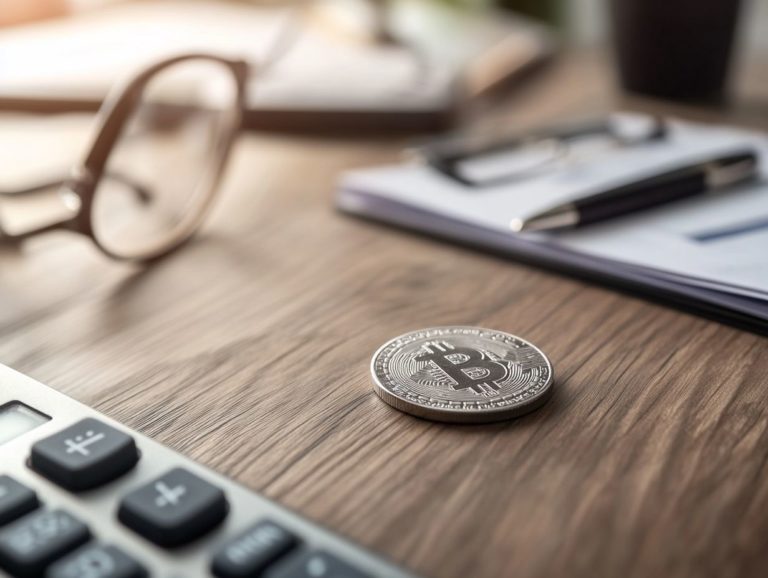The Future of Taxation in Precious Metals Investments
Are you ready to explore the benefits of investing in precious metals? This guide is your key to understanding tax laws and maximizing your investments.
Investing in precious metals has historically demonstrated a robust performance, serving as an effective means to diversify your portfolio. However, understanding the tax rules on these investments can be quite complex. This article delves into the current tax laws and examines changes that could impact your investments.
It also offers strategies designed to minimize your tax burdens while comparing precious metals to alternative investment options. Whether you re just starting your journey into precious metals or seeking to enhance your portfolio, this guide equips you with essential insights and practical advice to navigate the landscape successfully.
Contents
- Key Takeaways:
- The Role of Precious Metals in Investment Portfolios
- Taxation of Precious Metals Investments
- Potential Changes to Taxation in the Future
- Strategies to Minimize Taxation on Precious Metals Investments
- Alternative Investment Options to Consider
- Frequently Asked Questions
- What is the current tax situation for precious metals investments?
- Will the tax laws regarding precious metals investments change in the future?
- How might changes in tax laws affect the value of my precious metals investments?
- Are there any potential benefits to changes in tax laws for precious metals investments?
- How can I stay informed about potential changes in tax laws for precious metals investments?
- Is it wise to base my investment decisions solely on potential tax implications?
Key Takeaways:

- Precious metals can provide diversification and historically strong performance in investment portfolios.
- Current tax laws and regulations apply to precious metals investments, but potential changes in the future could impact investors.
- Investors can employ legal loopholes and tax planning techniques to minimize taxation on their precious metals investments and consider alternative investment options with differing tax implications.
The Role of Precious Metals in Investment Portfolios
In today’s economic landscape, the role of precious metals like gold, silver, and platinum has become increasingly significant. These metals offer a robust hedge against inflation and market volatility.
Historically, they have proven to be reliable stores of value, making them essential components of a well-diversified investment strategy. By including precious metals, you can enhance your capital gains while effectively managing tax implications.
The appeal of these metals comes from their intrinsic value and stability during economic uncertainties, thereby safeguarding your wealth across various market cycles.
Historical Performance and Diversification Benefits
The historical performance of precious metals like gold and silver underscores their effectiveness as a diversifying asset in your investment portfolio.
Throughout various economic cycles, these metals have demonstrated remarkable resilience against inflation and financial instability, acting as a safe haven during uncertain times. Events such as the 2008 financial crisis and the global pandemic in 2020 triggered significant spikes in demand for these assets, directly influencing their market prices.
As an investor, you often turn to gold and silver not just as a hedge against currency fluctuations, but also as a strategic tool for managing risk, especially when equity markets become volatile. Their intrinsic value tends to remain stable even when traditional investments falter, making them an essential component of a well-rounded investment strategy.
Taxation of Precious Metals Investments
Understanding the taxation of your precious metals investments is essential, as mismanagement could result in substantial tax liabilities. The IRS classifies gold, silver, and platinum as collectibles, subjecting them to capital gains tax rates that can soar up to 28%.
It’s vital for you to be aware of the reporting requirements, including the need to file Form 1099-B to accurately disclose any gains from selling these physical metals. Moreover, having a grasp of the tax implications can significantly shape your investment strategies, enabling you to maximize your returns while minimizing tax exposure.
Start investing wisely today to protect your wealth for tomorrow!
Current Tax Laws and Regulations

Current tax laws surrounding precious metals investments are intricate. They can significantly influence your return on investment.
Understanding these regulations is essential for anyone involved in buying, selling, or trading precious metals such as gold, silver, platinum, and palladium. The IRS treats these investments as collectibles. This means that capital gains from their sales may be taxed at a maximum rate of 28%, which exceeds the typical 15% or 20% applied to other assets. To navigate these complexities, consider exploring the role of precious metals in sustainable tax planning.
You’ll need to navigate specific IRS guidelines regarding the reporting of gains or losses. This includes factors related to holding periods. Staying informed about legislative changes that could impact your tax obligations is crucial. This vigilance helps ensure compliance while also maximizing your potential returns.
Potential Changes to Taxation in the Future
Potential changes to the taxation of precious metals could significantly reshape the investment landscape. This influences how you strategize your portfolio.
As debates about new tax legislation heat up, it s crucial for you to stay alert to potential adjustments. These may impact capital gains tax rates for gold, silver, and other physical metals.
The IRS is currently reviewing how it classifies these assets. Any shifts in tax policy could redefine the allure of these investments.
Grasping these potential changes is essential for crafting investment strategies that effectively mitigate tax liabilities.
Proposed Policies and Their Impact on Investors
Proposed policies regarding the taxation of precious metals have ignited significant discussion among investors. This is particularly due to their potential financial implications.
These policies could fundamentally reshape the investment landscape for precious metals. They may introduce new IRS classifications that change how gains are reported and taxed.
As an investor, you should assess how these adjustments might influence your strategies. Weigh the balance between traditional assets and the enticing draw of precious metals like gold and silver.
With potential tax rates on profits shifting, you may find yourself reconsidering your allocations and hedging techniques. This prompts a broader conversation about navigating the evolving market.
Understanding these emerging guidelines is essential for preserving your wealth and maximizing returns in an uncertain economic climate.
Strategies to Minimize Taxation on Precious Metals Investments
Developing effective strategies to minimize taxation on your precious metals investments is essential. This is particularly important for maximizing your overall returns, given the complexities surrounding capital gains tax regulations.
You need to identify legal loopholes and employ tax planning techniques. These will help you skillfully navigate the intricacies of IRS rules while optimizing your investment in physical metals like gold and silver.
By understanding the nuances of cost basis, which refers to the original value of your investment, and differentiating between long-term and short-term gains, you can structure your portfolio more effectively.
This will help minimize your tax liability and enhance your financial outcomes.
Legal Loopholes and Tax Planning Techniques

Identifying legal loopholes and employing effective tax planning techniques can significantly enhance the profitability of your precious metals investments.
Diving into the complexities of various tax codes and regulations can unlock opportunities to safeguard your earnings from excessive taxation.
Strategies such as utilizing tax-deferred accounts can elevate your returns on precious metals holdings. A thorough analysis of capital gains tax implications allows you to pinpoint the optimal timing for asset sales.
Consider rolling over your 401(k) funds into gold IRAs. This not only diversifies your investments but also offers significant tax benefits.
Ultimately, adopting a well-informed approach to tax planning can transform your precious metals investments into a more lucrative component of your financial strategy.
Alternative Investment Options to Consider
Investing in physical metals is undoubtedly a popular choice. However, you might want to explore alternative options that could offer added advantages and more favorable tax implications. Consider options such as ETFs and mutual funds.
For instance, gold ETFs allow you to gain exposure to precious metals without the logistical headaches of storage and security associated with physical holdings. These alternatives often come with unique tax considerations that can significantly impact your overall investment strategy.
It’s crucial to weigh these options thoughtfully and grasp market value within your portfolio’s context.
Comparing Tax Implications of Different Investments
Comparing the tax implications of various investments, such as precious metals, ETFs, and mutual funds, unveils crucial insights for discerning investors like you.
Understanding these distinctions can significantly shape your investment strategies and overall financial outcomes. For example, when you sell an investment, you may pay a tax on the profit, known as capital gains tax. While ETFs and mutual funds may enjoy lower taxes when you sell shares, physical precious metals typically face higher taxes, often classified as collectibles. To navigate this landscape effectively, it’s important to consider the future of taxation in precious metals investment. This nuance can lead to notably different net returns over time.
Additionally, tax-loss harvesting opportunities with ETFs provide a method to offset gains something that doesn t apply to physical assets like gold and silver. These subtleties are essential for you to make informed decisions, particularly when contemplating your long-term financial aspirations.
Frequently Asked Questions
What is the current tax situation for precious metals investments?

Currently, buying and selling precious metals is subject to capital gains tax. However, the rate varies depending on the metal type and the duration it was held.
Will the tax laws regarding precious metals investments change in the future?
While it’s difficult to predict the future of tax laws, discussions have occurred about potentially increasing tax rates for precious metals investments to generate more revenue for the government.
How might changes in tax laws affect the value of my precious metals investments?
If tax rates for precious metals investments increase, it could potentially decrease their overall value. This may also lead to a decrease in demand, as investors may seek other options with more favorable tax implications.
Are there any potential benefits to changes in tax laws for precious metals investments?
In some cases, changes in tax laws could benefit investors. For instance, if the tax rate for precious metals investments is lowered, it could increase their value and attract more potential buyers.
How can I stay informed about potential changes in tax laws for precious metals investments?
It’s essential to stay updated on tax laws and changes that may affect your investments. Consult with a financial advisor or follow reputable sources such as government websites or financial news outlets.
Is it wise to base my investment decisions solely on potential tax implications?
No, it’s not advisable to make investment decisions solely based on tax implications. Consider all factors, such as market trends and the potential for long-term growth, when making investment decisions.
Ready to invest wisely? Consult a financial advisor today!













